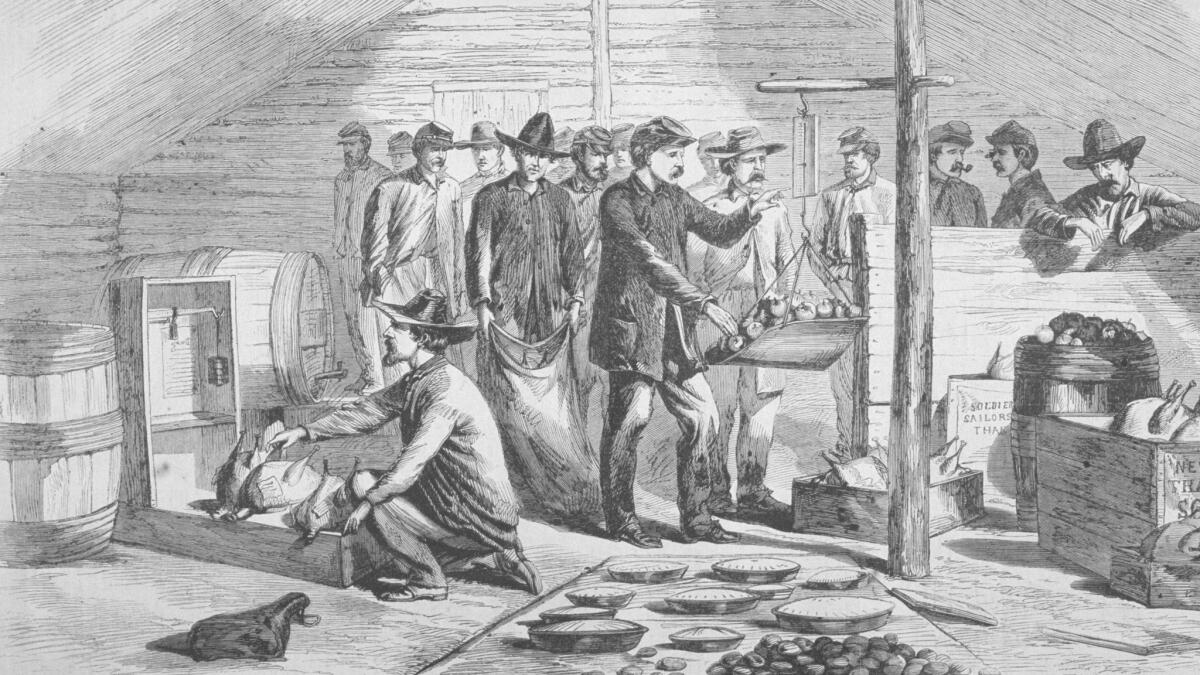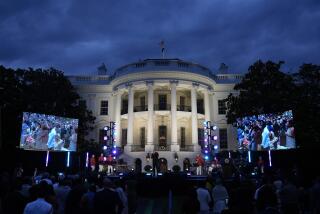In America, there was a time when even ‘Thanksgiving’ was a fightin’ word

Reporting from Atlanta — When Americans across North and South gather for Thanksgiving around tables laden with turkey and cranberries, perhaps the biggest regional disagreement centers on stuffing versus dressing.
It was not always so. In the runup to the Civil War, there was strong resistance in the South toward Thanksgiving itself.
“With the whole prospect of a showdown over the expansion of slavery, there was more and more rhetoric coming out of the South charging that Thanksgiving was pretty much a Yankee abolitionist holiday,” said James C. Cobb, professor emeritus of history at the University of Georgia.
While governors from Arkansas to Mississippi gradually embraced the idea of Thanksgiving in the 1840s, issuing Thanksgiving proclamations for their states, the idea of celebrating a traditional Puritan northern holiday became more contentious in the 1850s with the heightening temperature of the national slavery debate.
“Thanksgiving was, above all, a New England holiday, and New England was abolitionist territory,” as Diana Karter Appelbaum put it in her book “Thanksgiving: An American Holiday, an American History.”
Those who urged their fellow Americans to celebrate Thanksgiving as a national ritual were Northern evangelical Protestants who were strongly linked to the abolitionist movement. As anti-slavery sentiment swelled in the 1840s, many Northern ministers took the opportunity of Thanksgiving to rail against the moral wrongs of slavery.
Southerners, in turn, pushed back against the idea of Thanksgiving. Resistance to the holiday was particularly strong in Virginia, where local leaders viewed their state, not New England, as the cradle of the new American nation.
Thanksgiving became part of that checklist of Northern ideas we could do without.
— James C. Cobb, professor emeritus of history, University of Georgia
In 1853, Virginia Gov. Joseph Johnson refused to declare a day of Thanksgiving, defending Thomas Jefferson’s ideal of the importance of separation of church and state.
A few years later, his successor, Gov. Henry A. Wise, a slave owner, described Thanksgiving as a “theatrical national claptrap” that has “aided other causes in setting thousands of pulpits to preaching ‘Christian politics’ instead of humbly letting the carnal Kingdom alone and preaching singly Christ crucified.”
By “other causes,” Hale was referring to abolitionism.
Resistance to Thanksgiving went beyond the slavery issue, stoking states’ rivalries in the young American nation. In this sense, it was part of a bigger 1850s push by Southern leaders to discourage Southerners from sending their kids north to Ivy League universities, subscribing to Northern publications or hiring Yankee tutors for their children.
“Thanksgiving became part of that checklist of Northern ideas we could do without,” Cobb said. “Southerners would rethink the implications of Thanksgiving, simply because they were already more attuned to the idea that the South was dependent on the Northeast for manufactured goods and intellectual guidance.”
There were also differences of opinions about religious observance. To the extent that Thanksgiving had been celebrated across the South, it was mostly as a religious holiday, with Southerners closing businesses and attending church to hear ministers’ sermons rather than partaking in feasts.
Southern newspapers complained that Thanksgiving was an attempt to unseat the traditional religious holiday of Christmas. In November 1853, the Richmond Daily Dispatch insisted that “the grand festival of the South is Christmas, and we hope it will … never be thrown into the shade by any festival of modern invention.”
Complaining that “an astonishing quantity of execrable liquor will be guzzled,” the Evening Star in Washington, D.C., said that for thousands of residents Thanksgiving was “little more than an occasion for indulgence in dissipation at the cost of character, health and slenderly provided purses.”
It was not until the middle of the Civil War that Thanksgiving was declared a national holiday, largely thanks to the efforts of Sarah Josepha Hale, the influential editor of Godey’s Lady’s Book, a popular women’s magazine, and author of the “Mary Had a Little Lamb” nursery rhyme.
In September 1863, Hale wrote directly to President Lincoln, as she had written to presidents before, asking him to issue a proclamation that the last Thursday in November be a day of national thanksgiving. “Thus the great Union Festival of America would be established,” she argued.
A few days later, on Oct. 3, 1863, Lincoln issued a proclamation in celebration of a “year filled with the blessings of fruitful fields and healthful skies” to establish the first national day of Thanksgiving.
Lincoln urged his fellow Americans to take the opportunity to “commend to His tender care all those who have become widows, orphans, mourners or sufferers in the lamentable civil strife in which we are unavoidably engaged” and to “fervently implore the interposition of the Almighty Hand to heal the wounds of the nation and to restore it as soon as may be consistent with the Divine purposes to the full enjoyment of peace, harmony, tranquility and Union.”
Even after the Civil War came to an end, few Southerners celebrated Thanksgiving.
“Resistance to the idea of celebrating the Thanksgiving holiday on the Northern model hung on through Reconstruction,” Cobb said.
It was not until after federal troops left Southern states at the end of the Reconstruction era that Southern leaders began to embrace Thanksgiving as they sought to attract outside business investment and reinsert the South into national commercial life.
“There was this creeping incentive to conform, to demonstrate the South was ready to resume its rightful place within the union and prove its Americanness, or that it was the most American of all regions,” Cobb said. “One way of doing that was to accept national practices that it had scorned.”
Still, Appelbaum wrote, “pumpkin pies and turkey dinners were customs that Southerners had to be taught.”
Many ingredients used in traditional Thanksgiving menus, such as cranberries and pumpkins, were not well known in the South. Yet the rise of the mass media meant Thanksgiving menus spread swiftly in the South in the 20th century as national women’s magazines and national wire copy in local newspapers offered Southern readers advice on stuffing a turkey or baking a pumpkin pie.
Over time, the turkey and cranberry conquered the South — and the South, in turn, passed on many fine Thanksgiving traditions of its own.
A web of regional Thanksgiving traditions are now shared across the South and the nation, said William R. Ferris, a professor of history and senior associate director of the Center for the Study of the American South at the University of North Carolina. While a Southerner from rural Georgia is likely to roast a turkey in an oven and make a cornbread dressing, a Southerner from Louisiana might fry a turkey or make dressing with freshly caught oysters. With the mass migration of black Southerners over the last century, Ferris said, communities across New York and Chicago now celebrate with traditional soul food dishes of collard greens, cornbread dressing and candied yams.
“Thanksgiving is no longer considered a holiday that some celebrate and others won’t,” Ferris said. “With a focus on the food, the gathering of the family and friends, and the sharing of memory over the table, it’s embraced by everyone as an American experience.”
Jarvie is a special correspondent.
More to Read
Sign up for Essential California
The most important California stories and recommendations in your inbox every morning.
You may occasionally receive promotional content from the Los Angeles Times.











